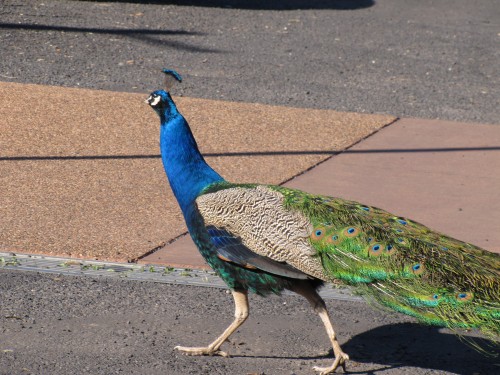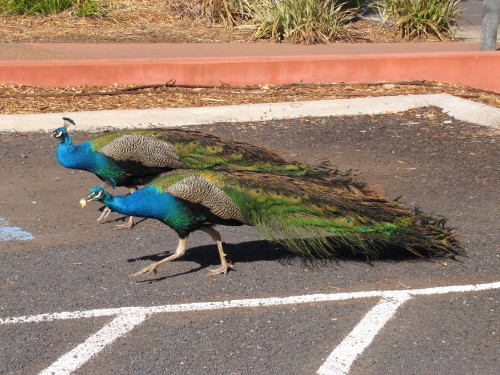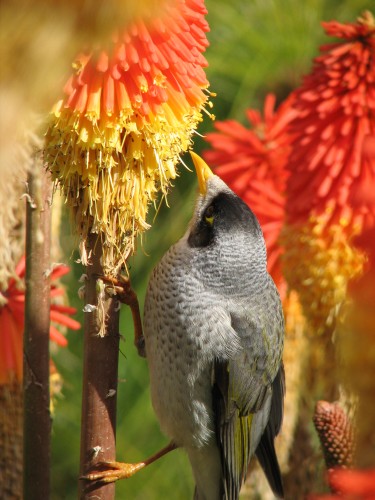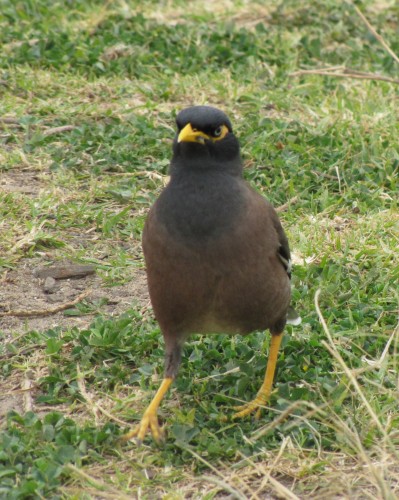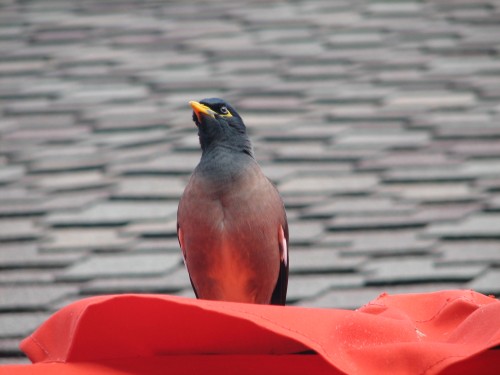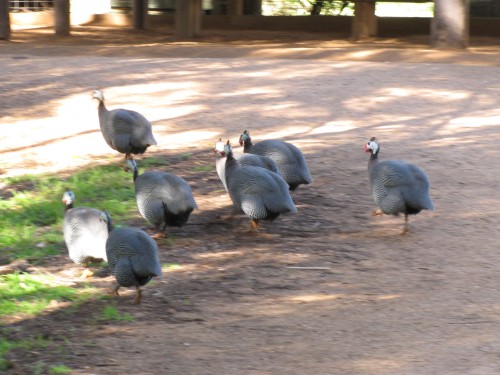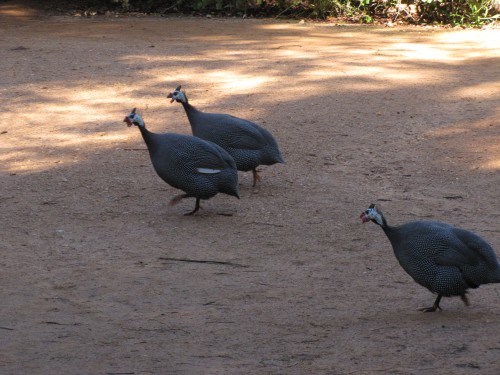Peacocks at Dubbo
Over recent posts here I have featured some of the birds I saw on a visit to the Western Plains Zoo near Dubbo, New South Wales. As we were leaving several peacocks strutted past us in the car park – all for the world like they owned the place. I have found that this is a common trait in this species of bird.
I should give this bird it proper name: Indian Peafowl. Most people I know will call it a ‘peacock’, but that is more correctly the name given only to the male. The female is called a peahen. The birds shown in today’s post are all males.
This most colourful and charismatic of birds is an introduced species in Australia. The species is native to India and Sri Lanka. Small feral populations exist in many parts of the world, Australia being no exception. They are a common adornment in zoos, parks and gardens in many parts of Australia.
Further reading:
An unusual sighting of a Chukar Partridge
Last week our neighbour popped in unexpectedly. We hadn’t chatted to her for a while so she was most welcome. She has known for years that I was interested in birds and had really enjoyed an illustrated talk about birds I gave some months ago to the local Senior Citizens group, Interestingly she had a bird field guide in her hand, open to a page showing a photo of a Chukar Partridge.
Her simple question was: ‘Is this bird found around here?’ She had never seen one before and was struggling to understand why she never seen it. She had been taking her dogs for a walk up the hill from our place. This is on the edge of Murray Bridge in South Australia and she was walking along the road through the start of an adjacent farming area.
This species is native to large areas of Eurasia. It has been introduced into Australia and I presume as game bird. In fact, some years ago some birds were released in the Gulgong area east of Dubbo in NSW. They never became established as a self-sustaining population. As there have been no sightings in recent years it is presumed they are extinct in that area.
So where did the bird seen by my neighbour originate? Interestingly, a year or so ago my cousin, who also lives here in Murray Bridge, sent me a photo of one in his garden. I can find no reference to this species being kept as an aviary bird though I guess that is one possible explanation if one has escaped. Perhaps someone has kept a few as meat birds and one escaped. Being a member of the pheasant family I guess that they are good eating. It is a wonder it has survived as we have quite a few foxes prowling the area.
I have no answers to these perplexing questions.
You can read more about this species here.

Miners v Mynas
I was a little amused last week when there was quite a flurry of correspondence in the Letters to the Editor section of our state-wide newspaper, The Advertiser. A reader wrote in complaining that something should be done about Myna birds in his suburb which he considered pests. He claimed that they were chasing away all the other birds, especially the smaller ones such at wrens and thornbills.
The next day the paper printed a whole page of rebuttals – or rather, a raft of claims of mistaken identity. Several years ago I, too, experienced getting into a long discussion with someone who was adamant that there were Mynas around the Salisbury area in the north of the city. They just would not be convinced otherwise.
The fact remains that there are currently no Common Mynas (also known as Indian Mynas) in South Australia. This introduced species is, however, relatively common in the eastern states and their range is increasing. Only last week my 7yo grandson reported that they now have them in their garden in Artarmon for the first time. (I have seen them up the street but never in their garden.) I have included a photo of a Common Myna below, taken several years ago in the Taronga Park Zoo in Sydney, a few suburbs away from my son’s home.
The species that the correspondent was concerned about was the Noisy Miner, an Australian native honeyeater species as shown in the photo above, taken a few years ago in the Adelaide Botanic Gardens. The Noisy Miner is a gregarious and mostly aggressive species which can be very dominant in some situations. Their bossy ways discourage smaller species like wrens, thornbills and other honeyeaters until those species leave and never return. One of the ways of combating their habits is to plant up gardens with smaller Australian native plants because they prefer more open, grassy, lawned areas.
As an interesting aside, we do not have Noisy Miners on our five acre block on the edge of Murray Bridge. They are relatively common along the river reserves and throughout the town, but in over 30 years they have never – to my knowledge – visited out property, though I have expected them for some years now. I did see one small family group about 500 metres down the side road from our place, but so far they have not moved any closer. We certainly do not want them invading our orchard – the Mallee Ringneck parrots are pest enough in the fruit trees. (Placing bird netting over the trees mostly works effectively.)
The threat of Common Mynas
The following is a quote from our government department PIRSA (Primary Industry):
The species is listed by the IUCN (World Conservation Union) as one of 100 of the world’s worst invasive alien species alongside Common Starlings, Red Foxes and Cane Toads. The Common Myna is a moderate pest of agriculture causing damage to orchard fruits such as fig, apple, pear, strawberry, guava, mango and grape. It also damages standing cereal crops including maize, wheat and rice.
In several countries it is considered an environmental pest and is reported to eat eggs and young birds and mammals including endangered species. The Common Myna aggressively competes for nest hollows and food, adversely affecting the breeding success of other birds and hollow-nesting mammals. It has been observed
attacking terns on islands as well as taking the eggs of other sea birds, possibly interfering with those birds’ breeding and general behaviour. The Common Myna is also known to spread avian malaria to other birds.
Further reading:
- Website: Primary Industry and Regions South Australia – this page lists 6 PDF documents relating to potential pest bird species in South Australia: Common Myna, Canada Goose, Red-whiskered Bulbul, Common House Crow, Indian Ring-neck Parakeet and Barbary Dove. It also has other documents relating to potential animal pests such as the Cane Toad.
- This is not a minor threat
- Birds in the Sydney CBD
- Noisy Miners causing problems
- Great birding moments #10 Noisy Miner Adelaide Botanic Gardens
Colombian hummingbird rediscovered
Blue-bearded Helmetcrest (Oxypogon cyanolaemus)
I don’t feature non-Australian birds very often on this site and I should correct this oversight. I have in the past shown birds photographed in Nepal, Thailand, Ethiopia, Morocco and Spain. (You can search for these using the search facility above.)
For two reasons I would love to go birding in Colombia, South America. First, it boasts the world’s largest list of bird species as well as the largest list of endemic species – that is, birds only found there and nowhere else. Second, I would love to visit the city of Cali, the birthplace of my two grandchildren.
News has come in recently of the rediscovery of a species of hummingbird, the Blue-bearded Helmetcrest (Oxypogon cyanolaemus) which had been thought to be extinct. The last sighting was as long ago as 1946. It must have been an exciting moment for the birders who made the discovery. To then manage to get the first ever photograph of the species must made the discovery even sweeter.
On the downside, the area in the Santa Marta mountains in Colombia where the birds were seen is under severe threat from clearing and burning by local farmers. I hope that provisions can be made to preserve both the birds and the environment on which they rely for their existence.
I can’t show the photo of the bird here for copyright reasons, so go to the link below. This will also take you to an interesting article about the bird’s rediscovery.
Further reading:
Helmeted Guineafowl
This is not a sight you see very often in Australia. Helmeted Guineafowl are an introduced species present in a few scattered locations around the continent. They are nowhere in abundance, only existing in a few locations and usually as a result of an escape from a farm, park or zoo.
This small group obviously have the run of the grounds of the Western Plains Zoo on the outskirts of Dubbo. I am assuming that this population is a self-sustaining group living permanently in the grounds of the zoo and feeding upon food left for other birds and animals.
This species is native to Africa but is often kept in small domesticated populations in various places around Australia. I assume that there are also some self-sustaining feral populations too.
My next door neighbour has about a dozen which often stray onto our property. I wrote about them here.
